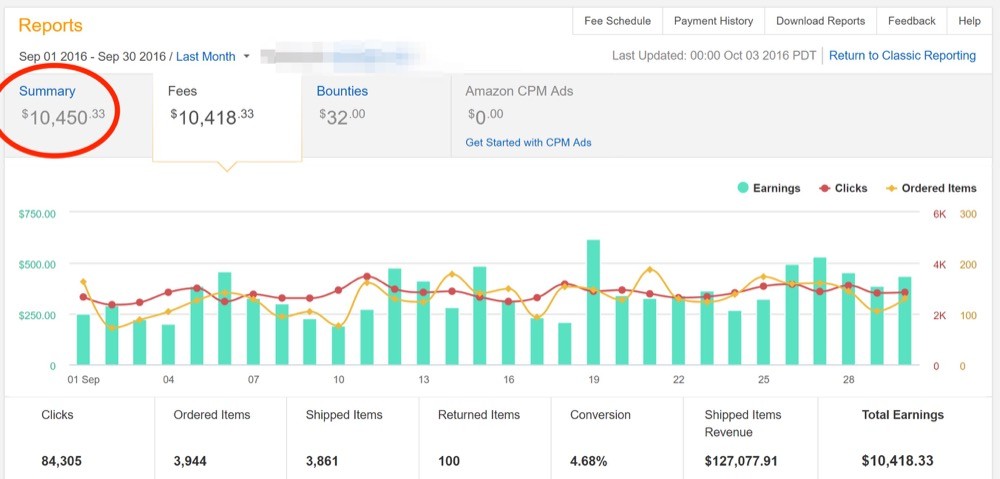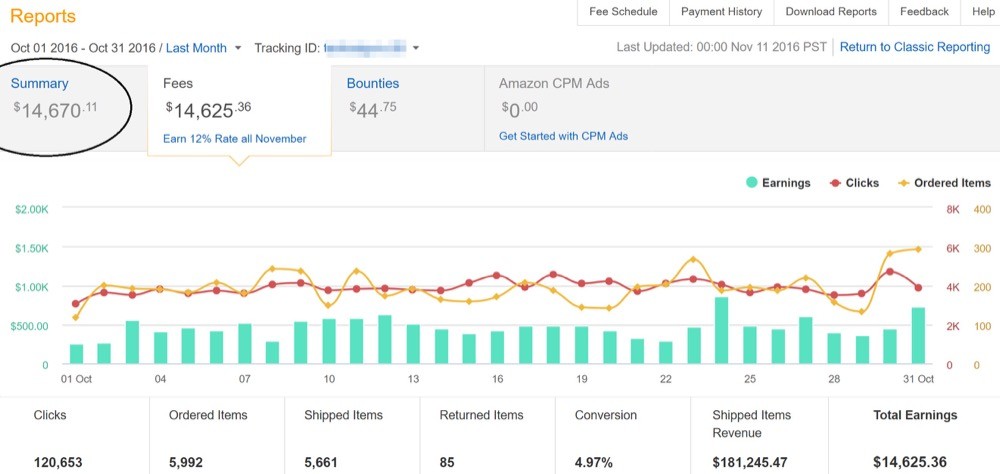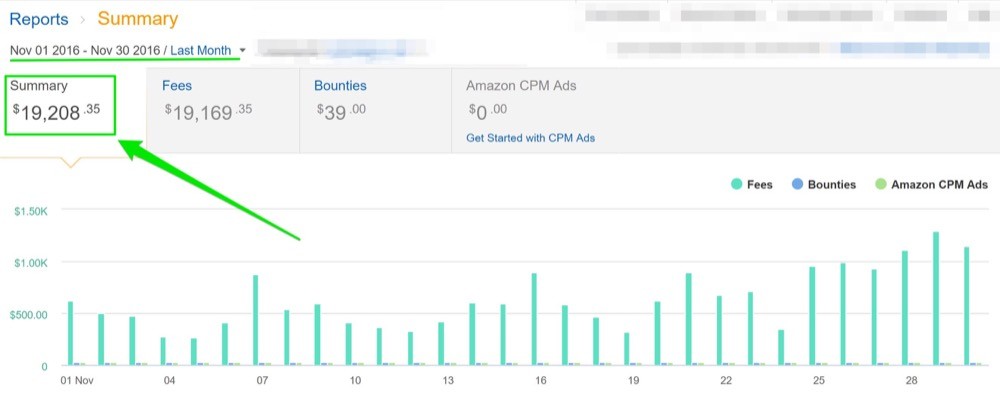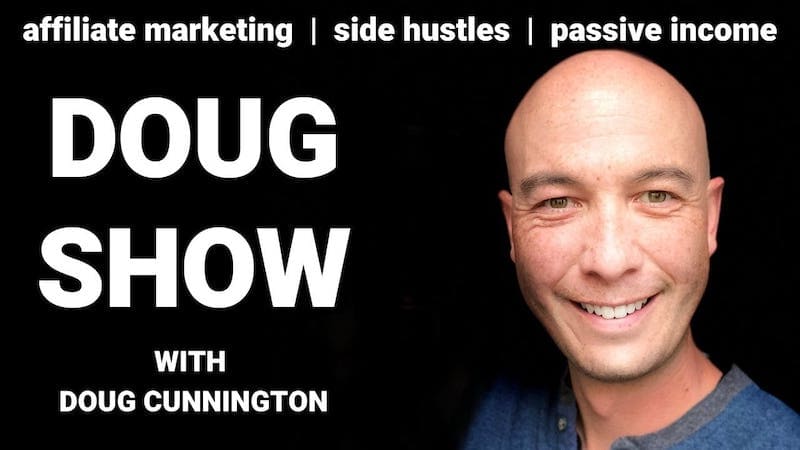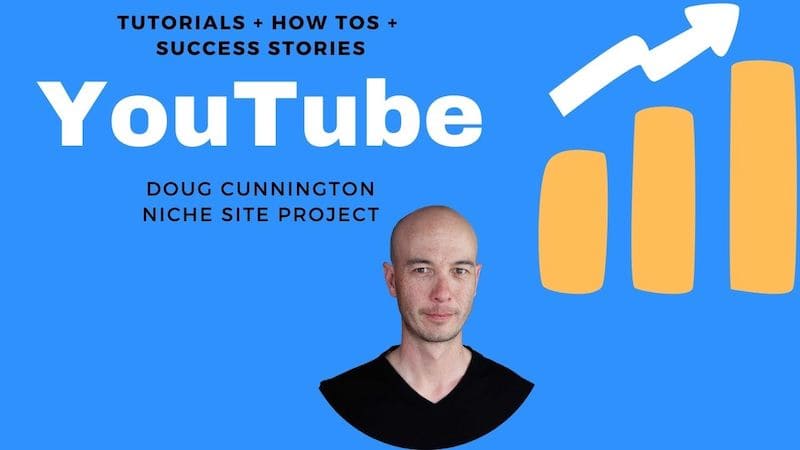I started working on a project in 2016 that ended with selling a simple Amazon Affiliate site for $235,000.
Crazy, right?
I think so too, and here’s the story which I blogged about in a 12 part series. I consolidated it down to this one, long post.
Some people call these niche sites, others authority sites, but either way they’re affiliate sites monetized with the Amazon Associate Program, other affiliate programs, and display ads.
There are product reviews on the site and visitors get to the site via searching on Google.
Some visitors buy something and then the website owner gets a commission. Simple concept overall, but it can get complicated fast.
Here’s an overview in a couple of videos and a playlist with some interviews if you want to check it out on YouTube.
Origin Story
The goal is to sell a niche site for over $500,000 after transforming it from Gray Hat backlinking to a White Hat site.
“Looks like we have a problem. NEGATIVE SEO. We have 183 new backlinks all with exact match anchor text,” said my partner in a Skype chat. “All new links added in the last 7 days.”
It was a problem. The site was getting 2,500 visitors per day and making about $333 every day. That’s a real problem for a site worth about $300,000 (based on the monthly profits times 25).
“What should we do?” I said.
That was 26 days into the partnership for this little gem of a niche site. It started a long time before that, though.
Background on the Project
This is the first post in a series that will document Project Go White Hat. It’s been a rollercoaster ride so far, and it’s not done yet. But the cool part is that these posts will get you up to speed fast, compressing months of work into a few posts.
Here are the critical stats to give you an idea about what this project is all about and why you should care…
The goal is to sell a niche site for over $500,000 after transforming it from Gray Hat backlinking to a White Hat site.
This isn’t one of those case studies where I’m starting from scratch. You know, the ones that take forever to get going and you wait for quarterly updates. This site is up and running, and you’ll be able to get up to speed fast, like binge-watching Breaking Bad on Netflix.
Proof of Earnings
Oh, here are the earnings for 2016 so you see the current numbers for the site. Check out the arrow indicating when I became a partner, in September. (Yep, I’m a partner BUT I’ll explain all that later and some interesting things about the partnership…)
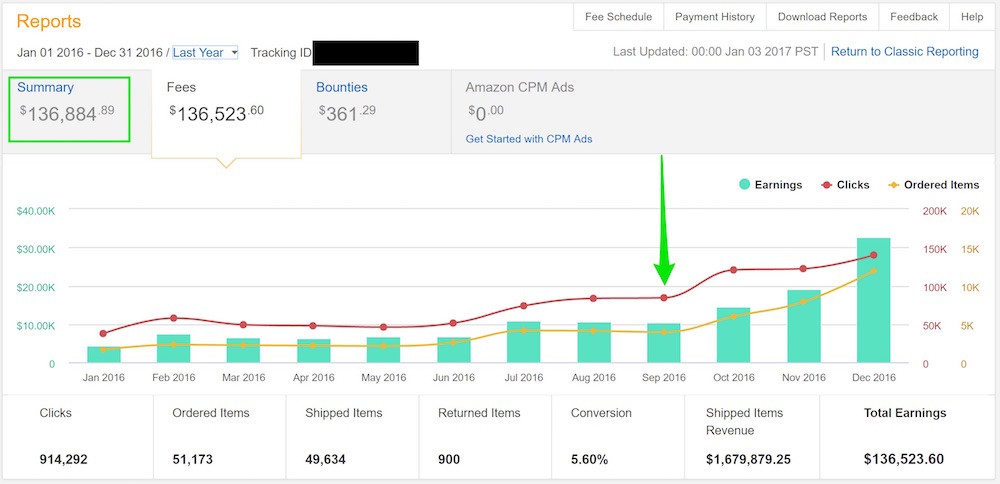
$500,000 will be a stretch, for sure! But you can see from the earnings that a Half Million exit is possible. Depending on how you value a site, this SINGLE Amazon Affiliate Site may already be worth over $500,000.
My Background and Personal Failures
Most people don’t talk about their failures and missteps, especially in a post like this.
They just showcase massive earnings, say it’s easy, and try to sell you some affiliate products.
“Hey, I made 6 figures a month while on the beach and outsourced it all. Just follow my plan and buy [insert-shiny-object-you-don’t-need]. Seriously, the whole thing is automated and only costs $17.“
But I say that’s BS and here is a reality check for you… Have a look at some of my silliest blunders and a few highlights:

Timeline
- Apr 2013 – Learned about Niche Sites from Smart Passive Income
- Jul 2013 – Launched my first Amazon Affiliate Niche Site
- Dec 2013 – My first site made $6,452 in a single month
- Jan 2014 – My first site dropped in rankings and earnings dropped to $100 per month
- Apr 2014 – Launched 5 new Niche Sites
- Apr 2014 – My house was foreclosed on
- Sep 2014 – All 5 Niche Sites were penalized
- Oct 2014 – Launched 1 new site: Site X
- Jul 2015 – Laid off from full-time job after 9 years at the company
- Oct 2015 – Niche Site X made about $20
- Jan 2016 – Niche Site X made about $100
- Jun 2016 – Niche Site X made about $826
- Dec 2016 – My wife got laid off from her job of 10 years
- Dec 2016 – Niche Site X made about $15,000
Here’s How I Got Involved
The partner, whom I can’t mention here, was chatting with me back in May of 2016 about his niche site. It was his big earner and it was growing. Here are some stats about the site at that time:
- About 45 pages or posts
- Ranking well in Google for some “buyer’s keywords”
- The majority of the traffic goes to one page, and when looking further reveals that Pareto’s Law is in effect. That’s the 80/20 rule. So 80% of the traffic goes to about 7 pages out of about 40 total pages.
- This site making $10,000 per month only has 45 pages. Proof that you don’t have to have a huge site to make five figures a month on an Amazon Niche Site.
The owner wants to sell but there are hurdles to jump over to even consider this, such as:
- The site has many private blog network links
- Some of the links are on a paid network with monthly fees
- There would be ongoing fees as the PBN links are non transferable
“Go White Hat” is Born
I had an idea to solve that problem – Go White Hat*. I have an outreach team that can help and specific skills in executing long-term, complicated projects. White Hat and Gray Hat refer to the link building and other strategies used to rank a site in Google search results.
*New to SEO?
- White Hat: Strategies that don’t violate the Google Webmaster Terms of Service.
- Gray Hat: Strategies that violate the Google Webmaster Terms of Service.
- In simple terms, the goal is to get rid of the Gray Hat links and replace them with White Hat links.
We iron out a deal over 10 days and some tough conversations. The important thing was to figure out the contingencies in case the unexpected happens. The unexpected often happens and plans always change.
We used mental models, or possible scenarios that could happen, to think about the things that could happen. Then talked about what we’d do.
I have a background in planning projects as a Project Management Professional (PMP). I treat it like a management consulting project:
- Identify Overall Goals
- Develop Requirements
- Create a Project Plan, Schedule, and Assign Responsibilities
- Take Checkpoints and Adjust as things change
- Complete milestones along the way
- Review the project after completion
We brainstorm on the plan for a few days. We throw out some less important stuff, but keep 3 critical things:
- Guest Posts to replace the PBN links
- Improve the existing content
- Add more long tail content that’s Keyword Golden Ratio Compliant
BAM! Negative SEO
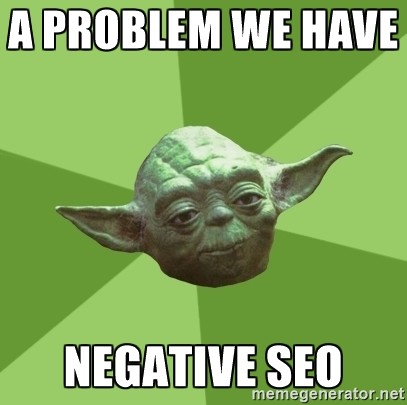 Negative SEO takes place, meaning a competitor is creating bad backlinks. This sucks since the aim is to trigger a penalty. It is not uncommon for this to happen in competitive niches.
Negative SEO takes place, meaning a competitor is creating bad backlinks. This sucks since the aim is to trigger a penalty. It is not uncommon for this to happen in competitive niches.
And from the opening, you’ll remember that 183 new backlinks were created in less than a week. That’s more than double the existing links!
If you aren’t familiar with Negative SEO, here’s what happens:
- Links are created using an automated link building tool.
- The links are blog comments with exact match anchor text for a page.
- The competitor’s goal is to trigger a Google penalty for “Unnatural Links.” Google applies this penalty when the anchor text ratio is out of whack.
The plan was to keep monitoring the new backlinks and closely monitor the impact. It’s tedious but necessary. If the links continue to be created, then we can reassess how to deal with it.
Starting a Guest Posting Campaign
At this point, we’ve started on the guest posting campaign. This is called Project Go White Hat after all.
It’s going great and the first 10 guest posts are accepted within about 3 weeks. The project is progressing faster than expected.
But my outreach team has made a HUGE mistake. They didn’t understand anchor text ratios – a basic concept in SEO and link building.
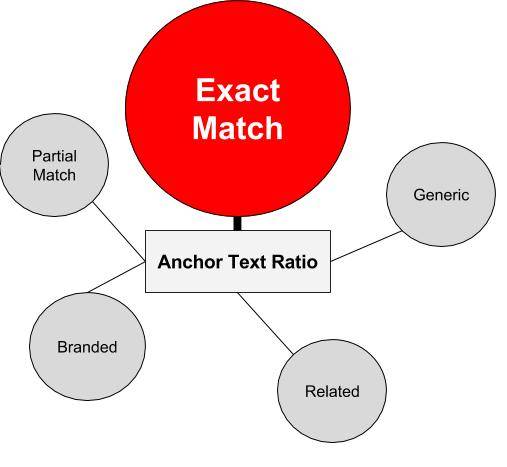 It was my fault 100% and here’s what happened:
It was my fault 100% and here’s what happened:
- 10 guest posts were pending publication
- 7 of them had the exact match anchor text
- This was a very big deal and I knew it. It’s like we negative SEO’ed ourselves!
I was dreading telling my partner because this could cost us HUNDREDS of dollars per day.
I took a few hours to think things through. Then, I thought about it some more over a beer not unlike this image.
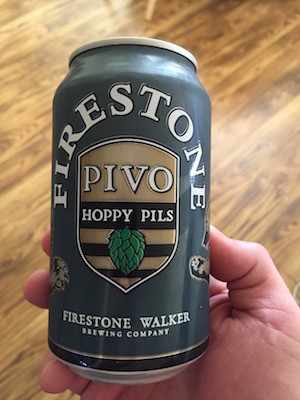
Coming up, I’ll tell you about:
- How my partner reacted about the major screw up on my part with the guest post anchor text and our plan to fix the problem.
- The plan to remove 15 POWERFUL private blog network backlinks.
- The next steps and the results, such as:
- The simple $200 tweak that boosted the value of the site by $100,000 and skyrocketed monthly earnings by 40%
- What happened when my content team nearly dissolved and my crazy idea to give them a raise when they turned in work late
- How it took 6 TIMES as long to get the second 10 guest posts as it did to get the first 10.
Negative SEO – Affiliate Site Nightmare
There’s a lot going on – ups and downs, solutions and new problems – so here is what is going on:
- The Anchor Text Debacle (with the 10 guest posts)
- Taking Massive Action:
- The $200 investment that yielded $100,000
- Plan to remove 15 private blog network links
- Adding more content
- Mo’ Money Mo’ Problems or Big Trouble in Little Niche Site (You’ll love the graphic!)
- The content team is falling apart
- Traffic starts dropping at the most critical time
- The guest posting team is failing
- Get the Content and Guest Post Templates here. It’s free – just enter your email address.
The Anchor Text Debacle
Here is what happened:
I was shocked to see that the exact match anchor text was used for 7 of the 10.
I have an outreach manager that’s in charge of the prospecting, sending email, sourcing the content, editing, placing backlinks, and anything related to corresponding with prospects. He did a great job with the prospecting and got started fast.
In fact, it only took a couple weeks for him to secure the first set of 10 guest posts. He did this so fast that he didn’t have a chance to have me look over the content first. I’m not a micromanager, but for the first sprint of guest posts I wanted to have a look to approve the quality and see the process.
I checked the status updates in our tracking spreadsheet and saw that all the guest posts had been sent out. The articles were all with the editors of the blogs, ready to be published.

But I was shocked to see that the exact match anchor text was used for 7 of the 10. So that means the anchor text was like “Product X Reviews” for 7 of the 10 guest posts. I knew this was a problem, but waited to make a move. (Remember, it’s a problem since the anchor text of the backlinks would be out of whack. That’s very bad, like crossing the streams, because Google could apply a manual penalty for “Unnatural Backlinks.”)
I needed to tell my partner. (I can’t mention who it is, but you probably know him!)
We do most of our communication with Skype so I chatted with him and explained the situation. We both agreed it was a major screw up – bad enough to potentially destroy the project.
We needed to act. Being a PM nerd, I took us through a risk management exercise to develop a solid response to limit the downside while NOT over reacting.
Brainstorm a Solution

There were a few things that we could do in response to the mistake.
- Do nothing and accept the exact match anchor text.
- Try to change the anchor text.
- Disavow the backlinks once they go live.
Review the possible consequences for likely outcomes
- Do nothing: The post might be penalized for unnatural links due to the keyword rich anchor text. This would be very bad and could jeopardize the success of the project. Earnings might be impacted immediately if the traffic went down.
- Change the Text: The blogger or editor might get annoyed and not publish the guest post so the effort and cost to get the guest post would be wasted.
- Disavow: The links would not be recognized and so the effort and cost to get the guest post would be wasted.
The solution was clear
Ask each blogger or editor to change the anchor text. The risk was the lowest for this option and had the potential for the highest upside.
The plan was simple, email all 7 of the bloggers/editors and provide them with a new version of the article. The email would say we made some edits to the post to clean it up. If we said anything about the anchor text, then it would seem more suspicious.
Execute the plan and wait
It took a few days to get the changes made but it was overall successful
I met immediately with the outreach manager to start the process. It just took a few minutes to get everything set up. Changing the anchor text was simple.
I like to use long phrases that are keyword rich because that’s what bloggers do. Some of the other posts were edited to include generic anchor text links like, “this post” or “here,” which is also very common.
It took a few days to get the changes made but it was overall successful. 4 of the 7 were changed to something different than the exact match anchor text.
The correction to the mistake was deemed a success overall even though we would still have to wait to see if there were negative repercussions. It seemed unlikely since the exact anchor text links represented less than 10% of the total links to the site. Plus, we knew that more links would be added further reducing the concentration of the exact match anchor text.
Lesson learned: Make sure the team has baseline knowledge
The whole mistake was my fault as the owner of the guest posting part of the work. Sure, my outreach manager was the one that actually performed the tasks but he was not to blame.
It was my fault due to a lack of training – I assumed he knew how important anchor text is for a link building campaign. He didn’t know even though he knew how to conduct a guest post campaign. It’s a subtle difference, but there is a big difference.
Taking Massive Action
We did 3 major things to increase the traffic and earnings. Here are the details.
The simple $200 tweak that boosted the value of the site by $100,000 and monthly earnings by 40% in 60 days
That sounds really impressive, and it is, but it was also very simple.
We improved the content on ONE page.
The most profitable page was bad with poorly written sections and a lack of understanding of the core product. Any person that had a small amount of knowledge about the core product would know that the writer had no clue what he or she was talking about! The content needed a full overhaul.
I used the Research Paper Method (RPM) to develop a strong outline. The RPM instructs you to treat the content like a research paper. Find resources, lots of them, then outline what should be covered in your content.
Once I had an RPM outline, I hired a writer to do the work. We added the content and the word count went from 2,000 to over 10,000.
The writing and editing cost about $200 for 8,000 additional words. That’s about $0.04 per word. (I know someone is reading this thinking, “Doug. Dude. You are overpaying for your content! I can get it for $0.015 per word. You’re getting ripped off.” I say to this imaginary person in my head, “My friend, you’re focusing on the wrong part. I’m happy to pay my team well, and I’m happy that you’re buying cheap content.”)
The traffic went up by a lot over a few weeks just by adding the content.
After 60 days, the traffic for the site was up by 40% and so were the earnings!
The earnings kept growing:
- $10k in September
- $14k in October
- $19k in November
Removing PBN Backlinks
This was the main task of the project: get rid of the powerful PBN backlinks and replace them with White Hat Guest Posts.
There were 45 PBN links total and they all needed to be removed before the site could be sold. Also, we wanted to have them removed early to allow the impact to be felt so the new owner wouldn’t be in for a loss in traffic or earnings.
We decided to keep it simple and just remove an equal number of backlinks per month. That’s to say we want to remove 15 backlinks per month over 3 months.
The backlinks were to a variety of pages throughout the site so we decided to spread out the removal pretty evenly. We agreed to remove 15 specific links for each month.
Sometimes it takes a while for the impact of links to be felt, and that applies to links being added or removed. So we just waited to see what would happen.
More Content, Applying 80/20, and More Changes
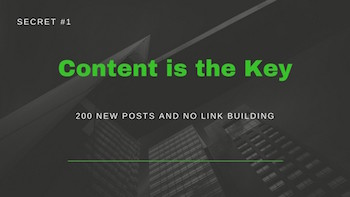 Adding the content to the highest traffic page worked so well that we wanted to add more new content and improve even more existing content.
Adding the content to the highest traffic page worked so well that we wanted to add more new content and improve even more existing content.
We identified the top 80% of the content traffic wise and figured out that it was just 7 more pages. Instead of a big, scary task of updating 30+ pages and posts, we narrowed it down to just a select few.
We ran the same drill:
- I outlined more content.
- My mystery partner approved it.
- I hired writers to do the work.
- I hired content managers/editors to process the content.
It’s the same system I used on my other site; it was just on a bigger scale so the impact was amplified.
Additionally, we needed lots of new content so I hired my friend from the Starting from Scratch Case Study, Jim, to find some great Keyword Golden Ratio compliant keywords. (Watch my video about KGR here…)
Like any good internet marketer with a project management background, I hired writers and a content manager to do this work for us. I use the same templates and job postings again and again and teach the same thing in the Five Figure Niche Site Course. Get the templates here for free.
The bottomline is that each new post cost us about $25 for 1000 words in cash outlay. That cost is a bit of a false because it ignores the cost of our time (planning, oversight, etc), and in the corporate world my time is worth about $100 per hour. For my internet marketing consulting time, it’s about $200 per hour. But the good part is that each article probably takes about 5 minutes of my time when outsourced properly. It’s really not much.
Big Trouble in Little Niche Site
A number of things started happening, and they weren’t in the original plan. It was bad stuff – like what Jack Burton in Big Trouble in Little China went through all those years ago. (Look it up…)
The content team is falling apart and most of the writers disappeared. It happened fast and at a bad time.
We were so impressed with the results from the 2-step content growth plan for one of my sites that we looked to do the same thing for this project. We also saw the value of growing the site to increase the valuation when selling it.
So, we decided to add about 50 new posts, some affiliate based and some pure information based. I built a content team with writers, editors, and content managers to handle the work and I served as the project manager for the work.
Everything was going well and some of the team was the same from my other niche site. In that instance, I added about 200 posts to my site and it resulted in a massive increase in traffic and revenue over a few months. It was a great investment of $4,000 for the content.
Then, the content team started slowing down. The average output of the team was about 20 – 30 articles per week, at about 1,000 words per article. That’s a lot of content, but it was necessary to have that additional content to get the site ready to sell.
The production level went down to about 6 – 7 articles per week. That’s a decent amount of content and for a site that only has about 40 posts, that’s reasonable growth.
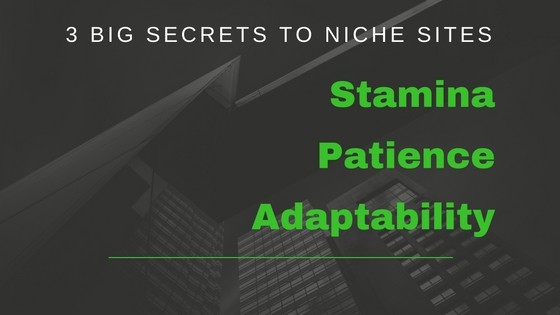
But it was way off pace. Plus, if you have the budget to push growth, then use it! We had the budget but didn’t have the team to do the work.
I stalled and stalled. I didn’t think I had the time to build out a new team. Not immediately addressing the production decline was a dumb move on my part since this project is potentially worth over $500,000.
Instead, I checked with the content manager to see if he thought the team would be back running at capacity soon. He always said, “Yes – should be good by next week…”
They never were. And our timeline was getting crumpled up and stepped on by all the writers that stopped writing for me.
Well, there was a more immediate problem too…
Traffic starts dropping at the most critical time.
After about 90 days of tremendous growth, the site started losing traffic and we didn’t know why.
This happened right in the middle weeks of December, and that means it’s the busiest time of the year – literally.
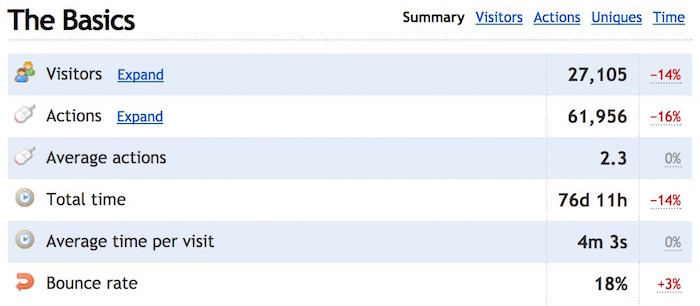
Each day in December up until the traffic drop, the site was making over $1,000 per day. Traffic drops sometimes for unexplained reasons, but something funny was going on because all the pages that were impacted happened to be the top traffic pages, like 80% of the traffic.
That was troubling since that means the traffic reduction could have been due to the content changes. We thought it may be due to over optimizing for the keyword on the pages or the keywords within the headings on the pages (the “h2” and “h3” tags). We had no idea what the real cause was!
The guest posting team is failing to reach its critical milestones
The outreach team was stellar at first and reached the first milestone of 10 guest posts in less than a month. Way faster than I expected. But the next 5 took longer, over 6 weeks, and things just got slower and slower. There was a stretch of 6 weeks when no guest posts were published.
It was clear that we’d be way off pace to replace all 45 PBN backlinks. I had to do something or we’d never finish our project and never reach the goal of selling the site.
I didn’t know what to do, just that I needed to do something.
Coming Up:
- The crazy earnings for the retail season: over $19,000 in November and $32,000 in December.
- The unexpected consequences of changing content. Hint: It made the earnings DROP.
- Using project management to address the guest posting failure.
- What happens when you remove 15 HIGH authority backlinks in 30 days.
Making $1,000 per Day
In life, people tend to wait for good things to come to them. And by waiting, they miss out. Usually, what you wish for doesn’t fall in your lap; it falls somewhere nearby, and you have to recognize it, stand up, and put in the time and work it takes to get to it. This isn’t because the universe is cruel. It’s because the universe is smart.
-Neil Strauss, The Game
Last time, the project started getting off track.
- The content team hit a rough patch and went from publishing 30 to 7 articles a week.
- The traffic dropped after we changed the content on the top pages.
- The guest posting team also hit a rough patch and couldn’t seem to get guest posts published at an acceptable rate.
When it rains, it pours. But the earnings are still up due to the 40% increase in traffic from the first 60 days. That’s due to the content improvement on the most profitable page of the site.
The site exceeded all expectations in November ($19,208) and December ($32,767) in spite of the three issues noted above.
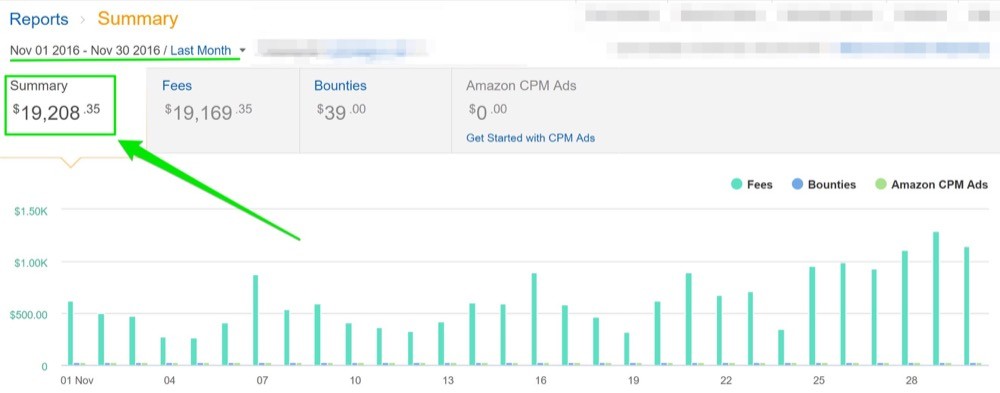
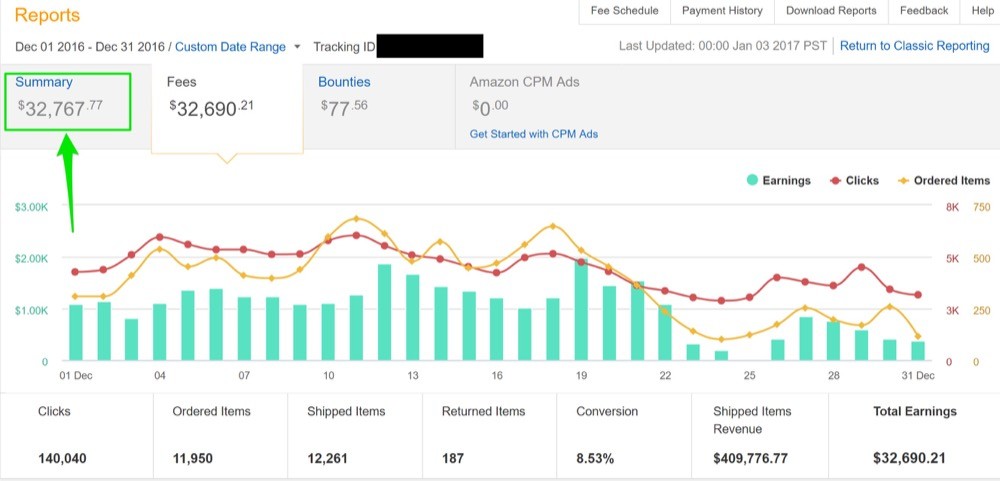
HOW and WHY did the site totally crush the expectations? This post is about the Hows and Whys.
If you are just joining us on the case study, you should check out part 1 and part 2. You should go do that now. (Okay, done?)
Remember this:
The goal is to sell a niche site for over $500,000 after transforming it from Gray Hat backlinking to a White Hat site.
Of course, we have 3 looming problems staring us down during the retail season, potentially losing HUNDREDS of dollars per day.
Using Project Management
In my old corporate job, no project went as expected. Things change. Problems show up and surprise you. Everything is going fine until the universe wakes up and knocks the breath out of you.
This isn’t because the universe is cruel. It’s because the universe is smart.
It’s all about how you react and what you do. If you expect the project to follow your carefully orchestrated plan, you’ll be disappointed.
We have 3 major issues going on and here’s what we did:
Guest Posting
The outreach team in charge of guest posting needed a kick in the butt. The problem was me: I wasn’t being a good manager for the team.
I let them direct their tasks, which was a mistake. I set new goals around success, namely I wanted the team to send out a certain number of emails each week.
Before the goal of sending out emails, they were focused on publishing 35 more guest posts, an overwhelming task that encouraged inaction.
My new goal for the team was attainable and easy to do since the team was comfortable sending out emails. Within 7 days, 4 new guest posts were published so they saw the value of trusting the process, too.
We are still way behind schedule but things are slowly improving.
Traffic Drop
We didn’t know what caused the drop in rankings which impacted the revenue. But since it was the week before Christmas, my partner took action even while he was on vacation.
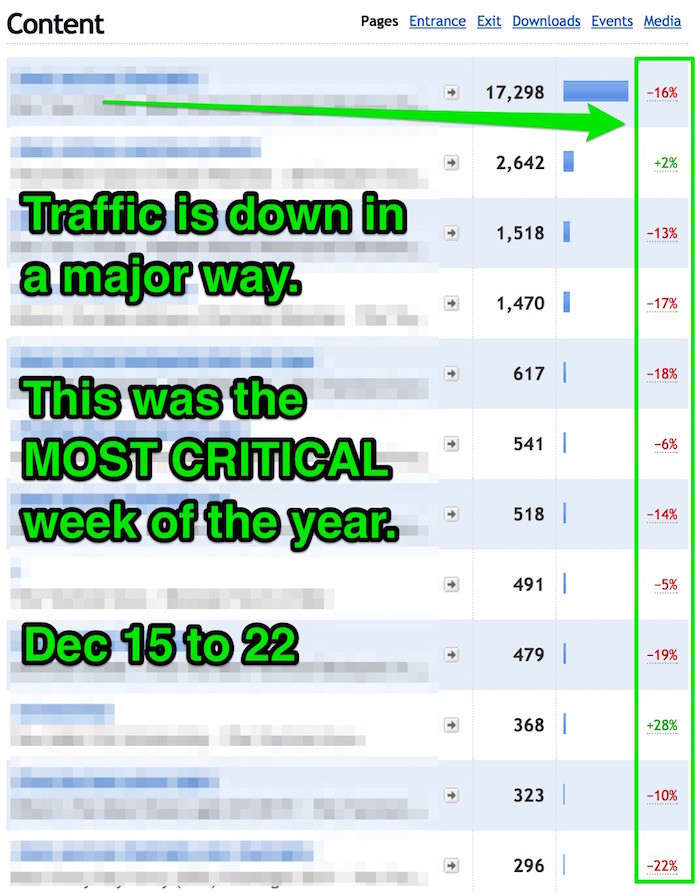
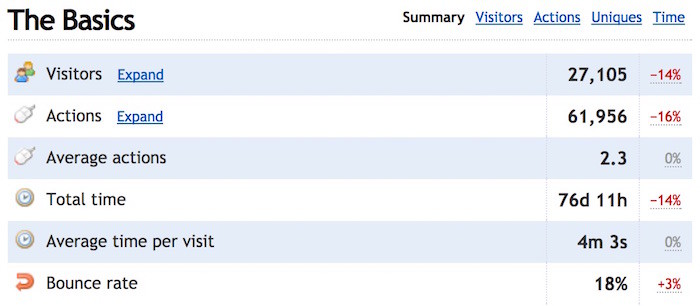
He reverted the updated content back to the original content. The new content was definitely better and written by more qualified writers, so it’s disappointing to have worse content published and driving a higher traffic volume.
Content Team
My content team was still struggling to write and not able to write more than 1 article per day. That delay cost us in December since those posts are Keyword Golden Ratio Compliant and would have ranked immediately. (Wonder what the KGR is? Watch this video and it’ll blow your mind.)
After stalling for weeks, I finally hired more writers to supplement the team which wasn’t easy to do around the holidays. I hired 3 new writers to write the articles that were pending in our list.
The Results
Guest Posting
The shift from goal-focused tasks to system-focused improved the output of the team right away. Unfortunately, we are still massively behind schedule and it will be impossible to catch up.
We have a problem because we need to do something to speed up the guest posting process even more, because we decided we want more guest posts than in the original plan.
Instead of 40 to 50 guest posts, we need to get 60 to 80 guest posts. There’s no guide, no formula, to take a niche site from Gray Hat to White Hat. This is unknown territory.
My partner and I made an assumption about the number of guest posts needed. After some heated debate, we agreed that increasing the target number of guest posts would ensure the rankings are stable after removing 45 powerful PBN backlinks.
Unfortunately, we needed to extend the timeframe of the project so the guest posts can be accepted and published. How are we going to get 20 to 40 more guest posts? I don’t know, but I know it won’t be a problem that’s solved overnight.
Traffic Drop
The traffic stabilized, but we can’t actually confirm that reverting to the original content caused it. I have another site where the rankings and traffic dropped over the same time period. However, the rankings and traffic returned without changing the content.
We’re unsure about what the long term impacts are from changing the content and reverting it back. Also, we need to republish the better, longer content no matter what.
Content
The additional writers took care of the issue with content. All the planned articles were written and published. Over the next few weeks, I expect each of the articles to get a few visitors a day due to top 10 rankings.
The problems are still not 100% resolved
Guest posting is way behind and we need more links than called for in the original plan. Removing the PBN links might be one of the things hurting rankings, traffic, and revenue.
The whole project is dependent on getting the guest posts published to replace the PBN links. The power of aged PBN links is greater than brand new guest post links, so we need to replace the PBN links at more than a 1:1 ratio to make sure rankings aren’t affected.
Removing 15 Powerful Private Blog Network Links
We removed 15 links and held our breath. That’s a lot of backlinks to get rid of in a 31 day period, and represents about 33% of the total referring domains to the site.
Removing the PBN links may have affected the rankings, traffic, and revenue, but we have no way of knowing! Too many factors were changing at the same time so there’s no way to know. The common knowledge says it takes weeks or months for the impact of links to show up in rankings, both for adding or removing links. Common knowledge is wrong all the time, so who knows for sure.
In the next part:
- Reveal my partner!. A lot of people want to know so we’ll be doing a “Behind the Scenes” discussion.
- Get his perspective on our progress so far
- Detail our next steps in Project White Hat
Secret Partner Revealed
I reveal my partner in this post. You’ll have to watch the video below to find out who it is!
Here’s a quick recap of the ongoing problems:
- The guest posting progress has been terrible. The main goal of the project is to replace Gray Hat links (PBN links) with White Hat Links. We’re basically halfway done with our original goal and already past the intended completion date. And to make things even more difficult, the revised plan is to get even more links than originally planned – About 80 guest posts total.
- Traffic dropped around the holidays. Initially, we…PANICKED…which may or may not have been warranted. We freaked out because we changed and updated a lot of content prior to the traffic drop. We reverted the content back to what it was before the change. Currently, traffic is still on the decline when compared to last month (Dec 2016), and that’s no surprise given the craziness of the retail season.
- Content production is lower than expected. The content team went from writing about 20-30 articles per week to about 7 articles per week. Luckily, at this point most of the new content is finished. This shouldn’t be an issue moving forward, and I’m still hiring new writers occasionally to keep a few people on call if needed.
Alright. Without further adieu…My partner and I talk about:
- WHO the partner is!
- The origination of the project.
- He thought the site may not even be profitable, even though it made about $136K+ in 2016.
- The struggles so far in the $500,000 case study.
- Plans for next steps and how we’ll get it done.
Guest Post Campaign Reboot
The goal of this case study is to convert a Gray Hat niche website to a White Hat Site. It’s extremely challenging overall and few people even attempt it. WHY?
Here is a great example of what many people think, and I’m going to pick on a friend of mine, Matt Allen, who stated it well:
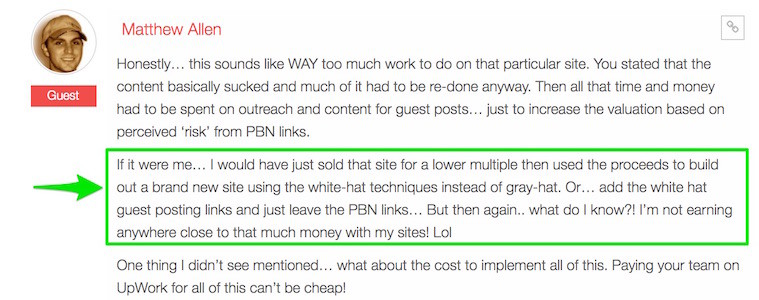
There is a lot to unpack in the comment that Matt left on a Guest Post I did on Charles Floate’s blog, but we’ll just focus on the green box. Many, many people have suggested the same thing to me: “Sell the site and start another one right, using White Hat techniques.”
(Here is my full response to the comment. And here is Matt’s blog, Dumb Passive Income. Coming Soon: Part 6 of this series will cover the expenses.)
Since you’re reading this, you know I didn’t sell the site and used my guest posting and team building skills to convert the site over to White Hat. It’s hard work; harder than just selling the site, but it’s meaningful work and I’ll learn things along the way.
We have one main problem:
Guest Posts need to be published, and they need to publish faster.
The Original Plan
Rob and I started on the project in August of 2016, though the site was about two years old at that point.
The plan was super simple, just four steps:
- Publish 45 guest posts by early January 2017.
- Remove 45 Private Blog Network links by January 2017.
- Put the site on the market at the end of January 2017.
- Sell in 1 – 2 months, or however long it takes.
A Fast Start, Then a Major Stall
The first 10 guest posts were published in about three weeks — Faster than expected.
He was hungry and wanted to really pump out the guest posts. I got sucked in by the enthusiasm.The guest posting went so well at first that we thought we could finish all the links by the end of December. I wasn’t personally doing the outreach, but I outsourced the work to an independent contractor that was a friend of mine. He was running a guest posting service, but was about 9 months less mature than my (now defunct) service.
The actual results were terrible! By December 31, the total number of links was about 18, far from the 45 that we needed. Worse than that was the lack of improvement:

Before long it was clear that we’d never hit the 45 guest post by the end of January. Only 4 guest post were published in the first quarter of 2017.
The 10X Rule
The 10x Rule by Grant Cardonne is a bit over the top in some ways. But Grant makes many excellent arguements. I reread the book at the beginning of the year as I was thinking about goals for the year.
The main takeaway:
Things take WAY more effort than you think.

Click on the image to see the book on Amazon. It’s an Amazon Affiliate Link.
We constantly underestimate the amount of work something takes. It doesn’t matter what it is.
Sometimes it’s because we assume the best case scenario will be the result, and it pretty much never is. I usually make that mistake and think things will go as planned.
I totally underestimated the amount of work and time it would take to get the 45 guest posts.
After acknowledging that fact, it was time think about where I made mistakes so that I could fix them.
Three Mistakes
I messed up in three ways (at least three!):
- I expected the best case scenario to be the result, i.e. I thought we could keep up the same furious pace of guest posting as the first three weeks. I forgot that guest posting gets harder over time, unless you change up your strategies to get new prospects.
- I failed to manage the team effectively. It’s been proven experimentally that people like to have autonomy in their work. That’s one reason why life style design entrepreneurs, digital nomads, or whatever you call them, are usually happier than when they had a corporate job. I let my outreach manager go with his own methods for too long. Then when I wanted to change the approach, he ignored my advice and kept trying to execute his methods which continued to fail.
- I failed to get involved soon enough. I kept hoping things would turn around, that guest posts would start getting published. In January, when it was 100 percent clear that the outreach team needed help, I realized I needed to get back in the game myself and hire my own team. By then it was far too late to catch up and still remain on schedule.
I realized that it would take more effort than I originally thought, and acknowledged three key mistakes.
It was time to move on, move forward, and build the team.
Building an Outreach Team
Rob and I talked about outsourcing some of the remaining guest post that need to be published. That number was 26 by January 19.
The site was making a healthy income, still five figures per month, so we could afford to invest and easily justify the costs. Plus, we made plenty of money in the last quarter of 2016 to more than cover the costs of guest posts.
Hypothetical Guest Post Costs
Let’s look at what that might cost to get 20 guest posts from various vendors. This is based on the assumption that guest posts are legit and high quality, obtained through networking, not a Private Blog Network.
- My old service – $6,000 for an average DA of about 30
- The HOTH – $3,500 for an average DA of about 30
- Fat Joe – $2,100 for for an average DA of about 30
- Love To Link – $3,690 for an average DA of about 30
- Guest Post Solutions – $1,200 for a range of DAs of 20 to 80
I’m admittedly a control freak and want to have things done in a particular way. Most of the time I can back up this obsessive nature with results.
The price ranges are crazy and you can pretty much assume that you get what you pay for. I kept raising my prices, and I still got customers. Eventually, I realized getting my own guest posts and backlinks were far more valuable for me than the money that people would pay me, so I stopped the service.
I thought about hiring independent SEO consultants instead of an agency to help control the prices and ensure real authentic outreach. The problem there is that the costs are still high and SEO consultants have their own idea about what to do. That could be good, but it could be a problem though. I’m admittedly a control freak and want to have things done in a particular way. Most of the time I can back up this obsessive nature with results.
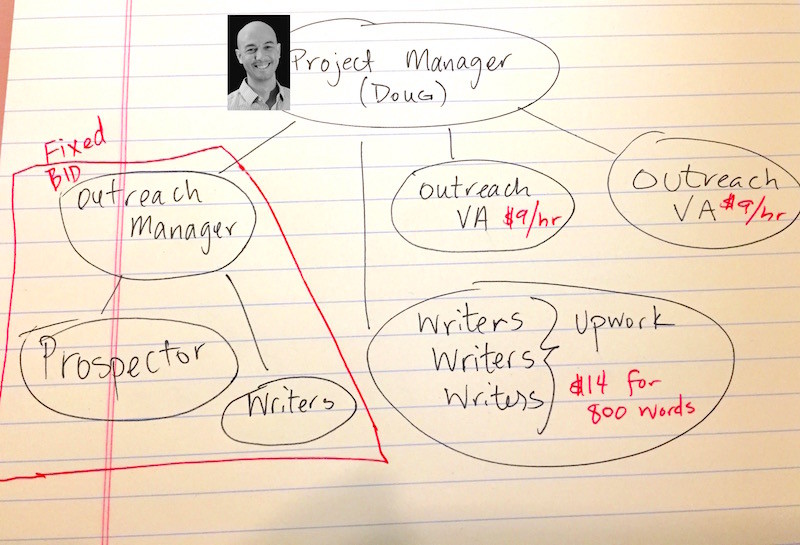 I took a step back to think about what I really needed. I wrote out all the things that an outreach manager needs to do. It turns out that all the steps are basic tasks that are easy to do.
I took a step back to think about what I really needed. I wrote out all the things that an outreach manager needs to do. It turns out that all the steps are basic tasks that are easy to do.
Sure, there are several tasks to complete and they need to be done in the right order, but no single step takes more than a few minutes.
The main steps are:
- Read a blog post.
- Comment on a blog.
- Check if the comment is approved.
- Comment again on the same blog.
- Email the blogger and be friendly.
- Email the blogger and pitch a guest post idea.
- Send the guest post to the blogger to be published.
What kind of person can follow directions, send emails, and be friendly?
Lots of people, including writers, executive assistants, and customer service representatives, and they are normally cheaper to hire than a SEO consultant. The upside is that they won’t second guess my tight, proven process.
I hired two outreach assistants and turned them loose at the beginning of February. I paid them $9 per hour and they worked for about five to ten hours per week. It takes a while to do the relationship building process, up to a few weeks. It took 3 weeks for the first guest post to go live.
After that slow relationship building period, things really took off. It’s the end of March right now, and I’m happy to report that 46 guest posts are live now.
It made me realize that I should have started building my own outreach team sooner. In fact, it would have been really smart if I worked in parallel with the original outreach manager. That’s totally ignoring the fact that I was doing a lot of other things at the time, so it may not have been possible. But in theory, it would have been a really good idea to get the guest posts done faster.
That’s compounded by the fact that Amazon changed the commission structure for its Associates program that cause a massive 35% reduction in revenue for the site. It would have been great to actually list the site at the end of January to potentially not take that 35% hit in revenue and correspondingly valuation of the site.
The Reboot Worked. Time To Move On…
It was a challenge to work on a big guest posting campaign. It took more time and effort than I estimated. Even worse, I was working with a friend (the independent contractor) that kept making promises about the work output that never came to fruition. If it was a contractor that I didn’t know, I would have fired him in October. Instead, I kept dealing with the lack of progress and hoped I could coach him to better practices.
Once I got back in the saddle to build the team, things got better after a few weeks. There was some ramp up time, and the self doubt never goes away. I really wasn’t sure if I’d be able to execute and generate the guest posts we needed with a meager, 3 person team, working 15 hours max per week total.
I’m happy to say that I can build a team that executes fast and has results to show for it. In fact, rankings and traffic have been improving since the outreach team landed some great guest posts.
Up next…
I started on the project over seven months ago and finally finished my portion of the work. Things aren’t finished yet, and here’s what’s in the next update, The Money Trail:
- The cost for 46 guest posts.
- The cost for content, both Keyword Golden Ratio content and improving content.
- Other content costs, like editors and content managers.
- Understanding the ROI.
- Why the ROI didn’t matter as much as you’d think.
- Some details on how the partnership is structured.
The Money Trail
This post is all about the money trail…The REAL costs of converting a site to White Hat.
I haven’t mentioned expenses very much in this case study.
Today, I reveal it ALL.
I mentioned that the monthly expenses were about $500 per month, which covered hosting, Private Blog Network links, and other normal overhead. Most of the $500 was for the PBN links.
The costs of converting the site to White Hat haven’t been mentioned in detail so that’s what this post is all about.
I wrote a guest post about the case study on Charles Floate’s blog. Matt Allen, from Dumb Passive Income, asked about the expenses, calling out the fact that it’s not clear if there is a positive ROI.
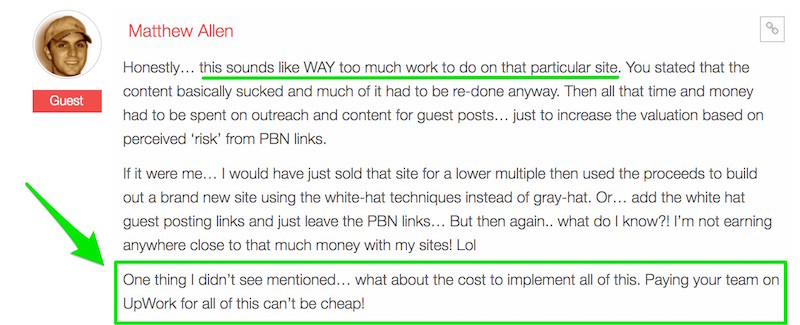
It is a fair claim in a world where Internet Marketers like myself don’t provide transparency into the financial realities. This is really irritating when I see the FBA (Fulfilled By Amazon) marketers talk about making seven figures a month and neglect to tell you that the profits are four figures a month.
I’ll talk about the costs, then the revenue.
The Costs
There are several expense categories in the project, and Rob and I did a pretty good job about what they might be. So there were few surprises.
Logistically, I paid for just about all the expenses upfront, then Rob would pay for his half of the costs at the end of the month. It was a bit tedious but helpful to see the numbers as an unofficial audit of the expenses.
Let’s look at the major sources of cost in the project so far.
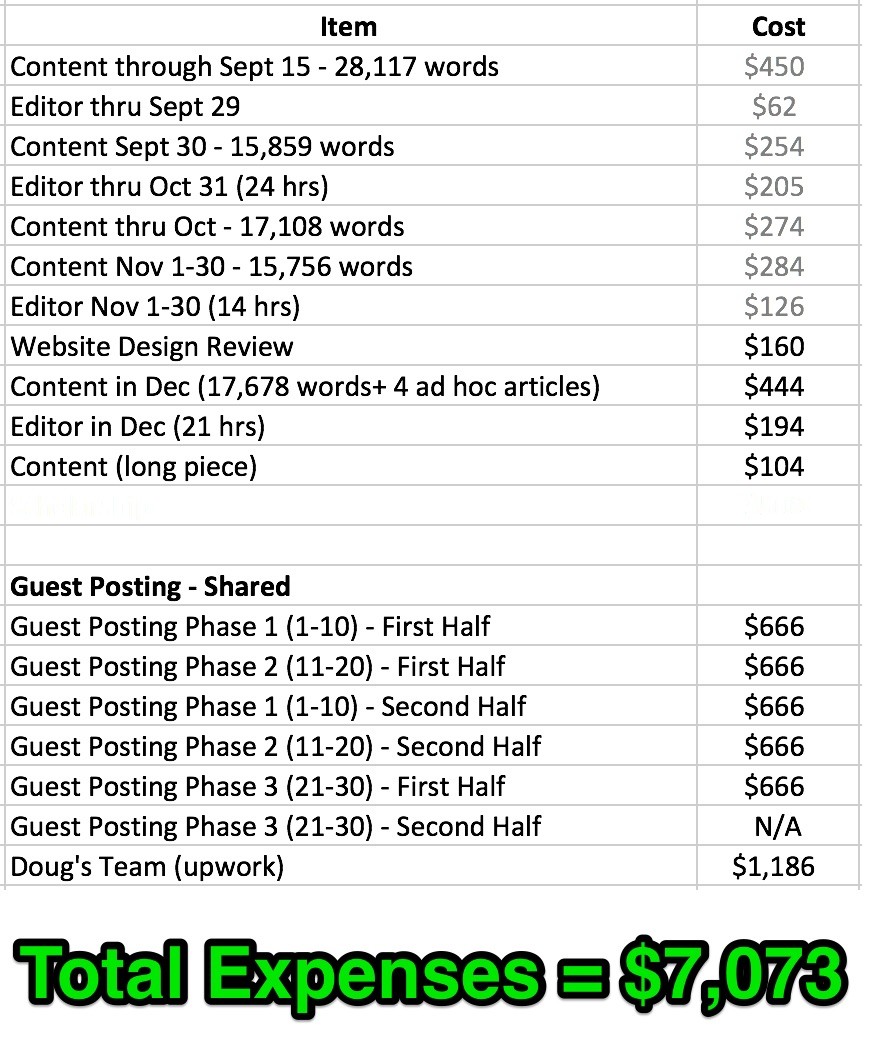
Content
We added a lot of content to the site, about 110,000 words. Most of the content was in the form of Keyword Golden Ratio compliant content. (Watch a webinar on YouTube on the topic)
Several other posts were systematically improved which yielded an increase in rankings and revenue.
I hired writers from Upwork and paid about $14 for each 800 to 1,000 word post, or about 1.55 cents per word.
New Keyword Golden Ratio Content
We added 99 new posts to the site, all KGR compliant. All that content amounted to about 94,500, at about 1.55 cents per word.
It’s staggering to think about that amount of content! Even now that it’s done.
We were able to utilize the team I already had in place for my other niche site. So it was actually easy to do.
In the chart below, Value is the number of visitors and Value Percent is the percentage of total traffic, and that’s for a 90 day stretch.
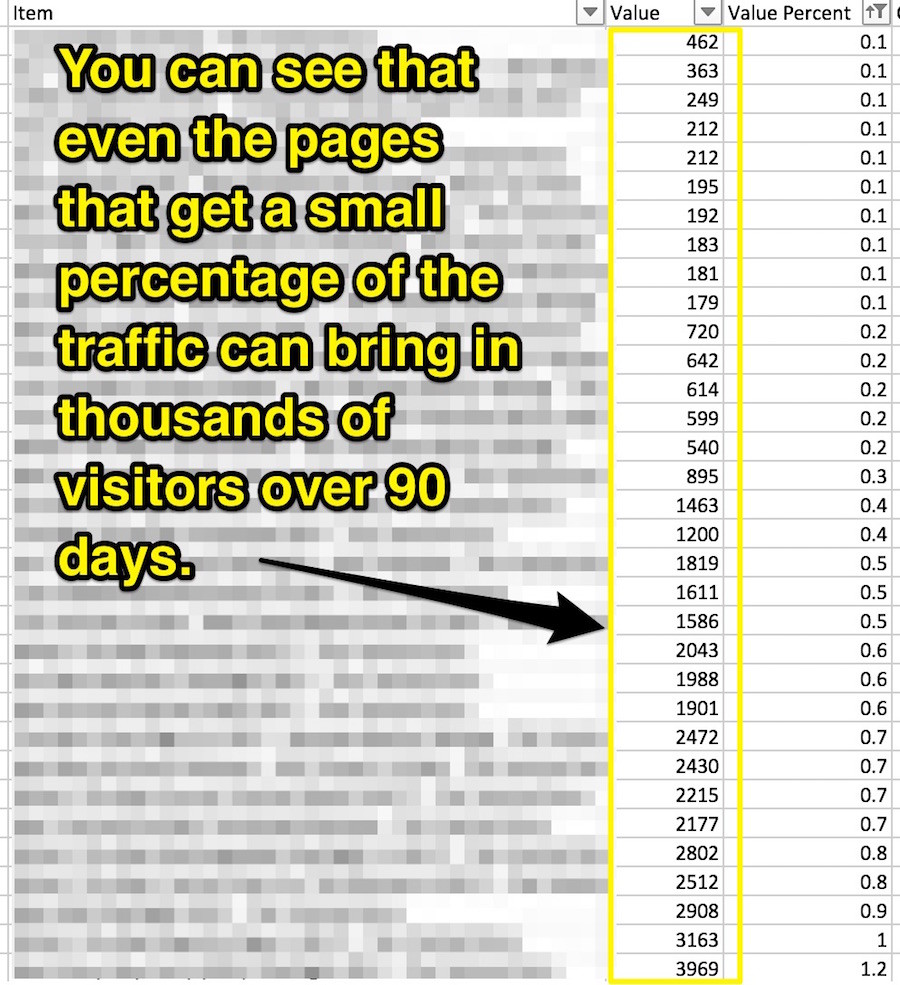
Improving Existing Content
A lot of the content on the site was bad. It wasn’t helpful and/or wasn’t written by someone that knew anything about the topic.
Nine of the original 45 posts, received about 80% of the traffic. So I applied the 80/20 rule and just worried about improving the content on those posts.
If we set out to do that for all 45 posts, it would have been overwhelming and the benefit of working on the other 36 posts would be minimal.
Here’s how we figured out which nine posts to work on… Remember in the chart below, Value is the number of visitors and Value Percent is the percentage of total traffic, and that’s for a 90 day stretch.

Editing and Content Management
The volume of content we were processing was, eh, A LOT. I don’t want to be in the business of reading a pile of content as high as a seven story building so I hired editors/content managers to help. This role was paid $9 per hour.
And for my team, the editor is the content manager – see below:
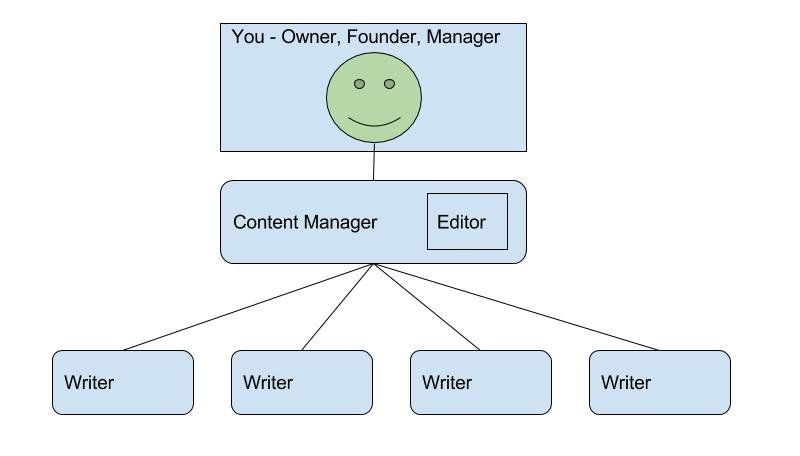
If you’re interested in the details of building such a team, and you should be, check out my post on Empire Flippers discussing How Entrepreneurs Build Teams.
The Editor/Content Manager Role does the following:
- Edits for grammar, content, and voice
- Adds images and videos
- Adds affiliate links
- Adds internal and external links
That would take me over one hour but my team can do it faster and better than me.
Plus, that would have been about 100 hours of my time! That’s two and a half weeks working full-time on content editing.
Content for Guest Posts
The content for guest posts was written by the same writers writing the content for the niche site content. So I paid the same rate as noted above, $14 per 800 to 1,000 words, or 1.55 cents per word.
Guest Posts
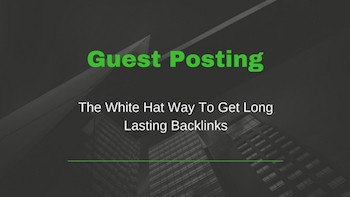 The guest posting campaign had two main components:
The guest posting campaign had two main components:
- A fixed bid* piece heading up by an outreach manager.
- A part that I ran with two VAs (paid hourly) and writers.
Each part component completed about half the work.
*Fixed bid means I pay a price for a result, a published guest post in this case, and the number of hours or resources needed to complete that work doesn’t matter. One guest post may take one hour to get, while another takes 20 hours, and I pay the same for each. It’s how nearly all SEO work of this kind is charged for.
Outreach Manager
I started the work for replacing the PBN links with guest post with this approach.
I was hoping (oh was I hoping!) that all 45 guest posts could be done by the outreach manager.
I paid $1330 per 10 guest posts for this fixed bid portion of the campaign.
This part of the team was great to work with in that I had one contact point: the Outreach Manager. He hired Prospectors and Researchers to help out. If he needed content, he got the content from iWriter. It was a blackbox for me.
As you know, that didn’t workout well and this part of the work stalled at 22 guest posts. It was hard to deal with since the campaign started so strong. Then, it just dragged on for a while and I kept hearing excuses about what the issues were.
From a management standpoint, I did suggest new modes of operation, new techniques that I knew to be effective, and even to hire more help if he thought it would help. None of my suggestions were taken.
In January, I got off my ass and sprang into action building a small team.
Outreach Assistants
At this point, we were way behind schedule with no signs of recovering without drastic action.
So, I hired two VAs to help me with a guest posting campaign. I paid them $9 per hour and used the same guest posting techniques that I’ve talked about several times.
I added a higher degree of interaction with the target blogs:
- More blog commenting
- More email interaction
And this extra care, the extra interaction made all the difference.
I was thrilled to see the progress and excellent results. My general VAs actually beat the experienced Outreach Manager hands down.
The sad part of it was that I told the Outreach Manager that more interaction with bloggers would improve the conversion rate back in October. He didn’t follow my advice so he didn’t improve the results.
The Revenue
Now, let’s look at the revenue over 2016 to 2017. Remember that I joined as a partner in September of 2016.
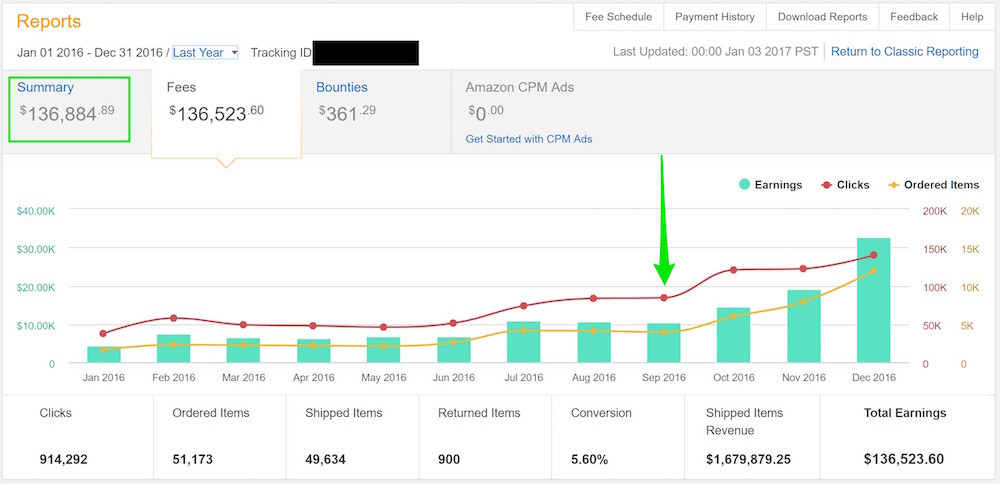
Then, the revenue in 2017.
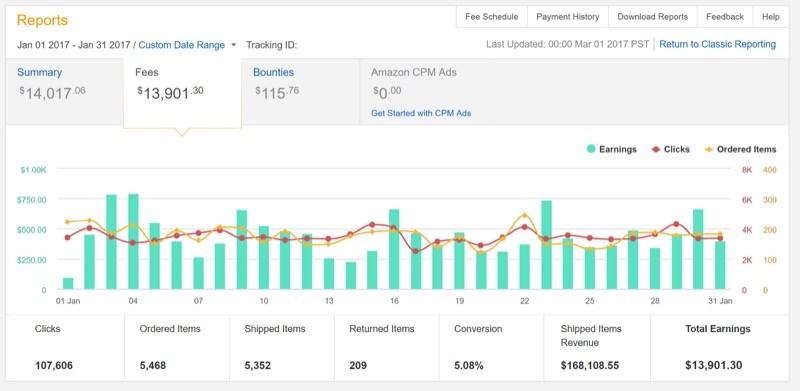
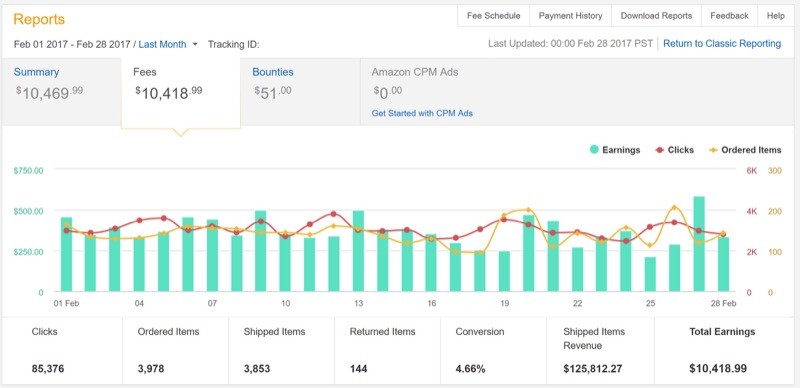
So, the expenses are not only covered by the revenue, I’m confident that the changes we made increased the revenue a LOT.
*I don’t have the March revenue handy, but it’s about 35% lower than we would expect due to the Amazon Commission rate changes.
Positive ROI
I acknowledge that I’m ignoring the time that Rob and I spent on the project. But I can say that both of us are busy on other projects and doing fun, non work stuff, and I know I only put in about 2-4 hours per week since starting on the project.
Coming Up: Amazon Commission Rate Change
We know that it’s a different landscape with Amazon after March 1, 2017 when it changed the commission structure. In part 7, I’ll tell you about:
- How We Found Out About the Change
- Panicking
- The Impact
- What’s Next?
Impact of Commission Rate Change
This is how I found out about the change in the Amazon Commission Structure.
We didn’t know the exact change until the last week of February, but we knew it was going to be a negative thing.
In February 2017, Rob pinged me on Skype and told me that Amazon scheduled a phone meeting with him.
It was about the change in the commission structure and it would go live on March 1, 2017.
We didn’t know the exact change until the last week of February, but we knew it was going to be a negative thing.
I could have posted something about it then but it would have just been speculation and not helpful.
In fact, most all of the information that was available at the time was through Facebook groups – hardly a reliable source of information.
I wrote a post here about the changes and felt it was a powerful blog post. I thought that because a lot of the people I talk to make good money, like a lot of money (how much do Amazon Affiliates make), from Amazon Affiliate Niche Sites.
However, I quickly realized it was like complaining about the Self-Driving functionality on Tesla’s – no one wants to hear that noise – It sounds entitled. Just be happy you have a Tesla.
So, I got off my soapbox.
Personally, I wasn’t too upset about it since it’s a great business decision for Amazon, and it’s their decision to make. I’m at their disposal.
The Impact
It’s bad.
Revenue is down by 36%.

Here is how we did the analysis:
- Took all the sales data from the Amazon Associates reporting area.
- Be sure to group the data by the Category.
- There are a bunch of categories so we just looked at the ones with the majority of the sales to save a bit of time. To be really specific, we applied the 80/20 rule again and looked at about 10 categories.
- We applied the new commission payments for the categories.
- Then, we had the amount we would have made in 2016.
- Last, compare the actual revenue from commissions to the new commission rates.
We also looked at the data for 2017 and got same result of a 35% reduction.
As an aside, I can tell you that most, but not all, people that I talked to experienced a 34% to 48% drop in revenue. However, it totally depends on the niche.
For example, my friend Will Blears (from One Man’s Brand) experienced just a 10% reduction, and actually refocused to increase the earnings by finding other affiliate programs. The takeaway is he’s in a niche that didn’t get reduced as much and apparently has several great affiliate programs.
What’s Next?
Well, at this point, things have changed. Project Go White Hat moved from hoping to increase the revenue by 50% as a long-term stretch goal to achieving a 300% increase within four months.
In December 2016, the site made $32,767 and reset our expectations, triggering a bigger goal:
Sell the site for over $500,000.
Some questions to ponder:
- Is selling the site for $500,000 even possible anymore?
- What would it take for us to sell the site for that much?
- Can we increase the earnings to at least $16,500 per month to command the $500k price tag?
- How long do we want to spend on the project?
- Were we dumb to think we could sell the site for $500,000?
Rob and I set up time to talk about this massive hit to the revenue.
I’ll tell you all about it in the next update.
Adapting to Changes in the Market
88The last Project Go White Hat update was all about how the monthly revenue for this case study site plummeted by 35% over night.
It was sad, we shed a tear, and got over it.
<blockquote”>This post is about the what Rob and I will do now that we clearly see that the value of the site is down as of March 2017…The REALITY of making high risk decision with incomplete data.
Business is full of surprises:
If you work for a corporation, like I did, you may get laid off when the market slows down. I was laid off in July of 2015.
If you work for a small medical billing company, like my wife did, you might get laid off when it is losing market share or when laws change. My wife got laid off two weeks before Christmas in 2016.
Or if you run an affiliate marketing business on the platform of one of the biggest retailers in the world and they change the commission rate, you might take a massive pay cut.
Check out the timeline for my affiliate marketing journey — It’s a roller coaster!

The ability to adapt to changing conditions is a great skill to have. Internet marketing changes fast, and as marketers we need to accept that fact and react quickly.
It is not the strongest of the species that survives, nor the most intelligent that survives. It is the one that is most adaptable to change.
—Charles Darwin
I’m happy to say that Rob and I have been able to adapt as partners without any reservations.
Sunk Cost Fallacy
This is a behavioral economics concept. I became most familiar with it after reading the Freakonomics books, and now, I’m better equipped to deal with it.
The Sunk Cost Fallacy is when you keep doing something simply because you’ve already invested time, money, or effort in it.
Even though we know that continuing to invest time, money, or effort is a waste we keep doing it.
Examples:
- If you go out to dinner at an All-You-Can-Eat restaurant, then you overeat until you feel sick just to get your money’s worth. (I’ve lost about 20 pounds by not frequenting such establishments over the last few years.)
- If you’re at a job you hate and have been for years, but stay there anyway since you have seniority.
- If you start a niche site, spend 6 months working on it, then realize it’s a terrible niche that can’t be monetized well, but you continue to spend time on it.
Amazingly, Rob and I are exceedingly pragmatic and rational people. I’m probably hyper-rational and lack some emotion, but in this case for Project Go White Hat, it’s really a great asset.
We aren’t falling for the Sunk Cost Fallacy, and if I explained it well, then you already know what I’m about to say.
Rob and I aren’t chasing this short-lived dream to sell a niche site for $500,000.
Yep, even though I proclaimed such on this blog and within a few guest posts. Does it mean I lose credibility? No, not necessarily.
From where I sit, the rules of the game changed. Things are different than six months ago or even two months ago.
Let’s review the two main options:
- Try to sell the site for $500,000 which requires increasing the revenue by about 2x. That’s no simple task given the level of revenue. Doubling the revenue of a site making $100 or $1,000 is easier than going from $8,000 to $16,000. Could it be done? Yes. How long would it take? It’s hard to say but at least a few months in the best case scenario, and I can tell you the best case pretty much never happens.
- Finish out the original plan, which is to get rid of the PBN links and obtain 45 guest post links to replace them. Then, sell the site as fast as we can since we are behind the original schedule.
Doubling the revenue of a site making $100 or $1,000 is easier than going from $8,000 to $16,000.
Business and life are full of surprises, and things beyond our control change all the time. It’s not a matter of “if,” it’s a matter of “when” things are going to change.
The people that are going to win are the ones that can make tough decisions with limited information and a high level of risk and minimize losses. (At least, that’s what I’m telling myself.)
Three years ago, I would have prolonged the project and tried to recover, maybe spending a many more months working to push a boulder uphill.
I’m not going to lie: It would be cool to sell a site for $500,000.
But working on a big, aggressive project teaches you a lot and opens doors for you. I recently read the Scott Adams book called “How to Fail at Almost Everything and Still Win Big,” and one of the main strategies is to choose projects that will teach you something and expand your network.
That way even if the project fails, you’re better off for working on it. He frames it as a systems approach, not a goal oriented approach.
If we sell the site for $200,000 instead of $500,000, that’s still pretty good for a two and a half year old business with profit margins close to 90%. From a learning stand point, it’s been tremendous.
What’s Next?
In just a few days, we’ll be starting the process of selling the site through Empire Flippers. Here are some of the many uncertainties:
- What will the site be valued at?
- Will the White Hat guest posts actually boost the value of the site? (The lack of PBN links should reduce the overall risk for the buyer.)
- What will the list price be on the Empire Flippers marketplace? (We could list it for less than the price that’s determined to make it more attractive to buyers.)
- How long will it take to sell?
Accepting Changes and Adversity
“They’re gonna wire the money in a few days.”
“Hell yeah!” I said.
This series is about converting a site from Gray Hat to White Hat.
Wow…that’s the kind of wire transfer that’s monitored and reported to the IRS.
Six figures.
Wait. Let me back up…
That was Rob telling me about the wire transfer…And I need to go back even further.
A Little Update
The last time you heard about Project Go White Hat bad things were happening.
- I took over the guest posting campaigns. This was good since I finished the campaign and replaced 45 Gray Hat backlinks with 48 White Hat guest posts. But it was way behind schedule by the time I finished.
- Amazon changed the commission structure and earnings dropped by 35%. This was bad, but out of our control.
- Rob and I decided to cut losses and list the site as soon as possible. This is business.
What are the latest stats for the site now…?
After the retail season, the site has been declining in traffic and earnings. Of course, you can take 35% off of what it was earning before due to the change to the Amazon Associates commission structure.
But the traffic was declining too.
Traffic
Here’s the data from Clicky from January 1 to May 31, 2017. The lighter line is the previous period covering the retail season.
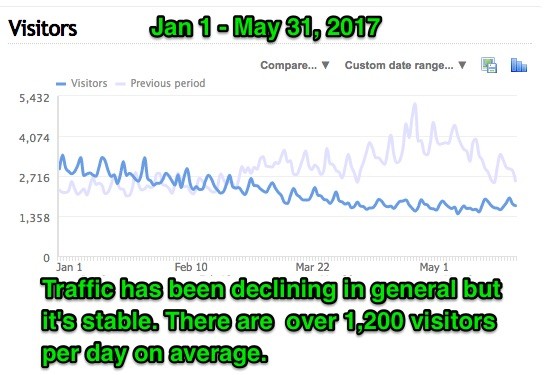
So you can see traffic is down a lot, but not too much when you look back to the middle of 2016. It’d be better if the traffic was higher, but it’s not as terrible as it looks since that’s still over 1,200 visitors per day.
Why is the traffic lower?
I could make excuses about how the relevancy of the guest posts should make a difference, but who cares about excuses.
Well, it’s because we replaced the Gray Hat PBN links with White Hat guest posts. The PBN links were links from the home page of sites with high authority, passing lots of link juice.
The guest posts are generally on less authoritative sites and don’t have many backlinks to them, if any. They were relevant links in most cases. But overall the replacement links weren’t direct replacements.
I could make excuses about how the relevancy of the guest posts should make a difference, but who cares about excuses.
And I’m pretty sure this is what happened:
The PBN links were removed and the rankings dropped some, especially for the long tail keywords.
We aimed for a few extra guest posts for this reason, but the right ratio is probably closer to two guest posts per PBN link. We just had three extras.
Did the traffic impact earnings…?
Earnings
You bet it impacted earnings. Earnings are trending down.
Let’s go down memory lane and look at the earnings for December 2016, January, February, and March of 2017 so you can really feel the trend.



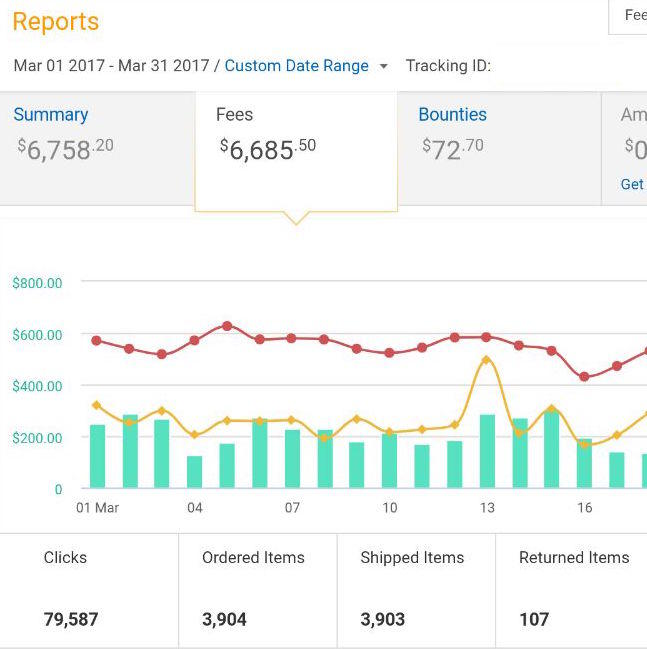
The decline seems insane if you just look at December to March. But if you think back and recall that the site:
- Was making about $10,000 per month for a lot of 2016.
- Amazon cut the commission by a lot (~35%), then these stats seem realistic.
It’s sad for sure, but hey, this is business! And we started this project with the goal of selling the site.
“For Sale!!”
We need to list the site with a broker. Empire Flippers is our choice, and there are pros and cons with working with them which is something to discuss in part 10.
We are nervous.
Earnings and profit are the main valuation drivers for any business and that applies even more for websites.
A brick and mortar business might have assets that can have value even if they have a negative cash flow or have debt.
For example: A brewery might not be profitable selling beer and could lose money every month. But they might own $500,000 of brewery equipment and have a large taproom. Those assets may be really valuable to someone.
A website, like this authority site, isn’t really that valuable if it isn’t earning money. Let’s look at the assets:
- A Hosting Plan that’s only worth about $10 per month because it’s a Virtual Private Server (VPS).
- The content is just bits and bytes, words that can be replaced for a couple thousand dollars.
- And I’m struggling to come up with other assets!
It’s amazing if you look back the growth since the project started. The earnings were great through December of 2016, essentially growing by 300%.
After the retail season, we expected a decline in revenue, but you never know how that will work out. You never know when the sales and earnings will taper off.
Traditionally, you’d see a strong January, and I say that’s because people are using their gift cards.
You can see the decline in the earnings, and luckily, they stabilize.
The Next Steps
Rob and I accepted the fact that we could have sold the site last year and probably could have made a lot more money.
Maybe up to $100,000 more which hurts to acknowledge. We can’t see the future, though, and we made the best decisions we could at each point in time.
We’re happy with that.
Acceptance.
And that means the next steps are:
- Start the process of listing the site with Empire Flippers.
- Accept and negotiate the value of the site with Empire Flippers. Rob and I feel so strongly about selling the site fast that we agreed that we’d considered LOWERING the sale price below the valuation.
- And the big thing that we’d learn about is whether or not a White Hat Site will have a better multiple than a Gray Hat Site.
That’s one of the biggest criticisms that I’ve gotten from people:
- “Doug, if I were you, I would have sold that site in 2016 and reinvested in a brand new site.”
- “You shouldn’t worry about Gray Hat links! You won’t get a higher multiple and you’re wasting your time.”
You know, stuff like that. Thoughts to make you question your sanity! But it goes with the territory. I’m glad people have opinions, even negative ones, about the project because then I know it’s interesting.
Coming Up
- REVEALED: The valuation of the site (and it was way more than we expected!)
- Working with Empire Flippers
- The site listing with full details
Listing with Empire Flippers
This is one of the most important updates in the Project Go White Hat series.
You’ll see the valuation of the site, plus the complete listing and some offers from buyers!
It answers one of the main questions about the whole project:
Are White Hat Links are better the Gray Hat Links for a valuation?
You saw the latest earnings and traffic stats in Part 9. Rob and I were thinking, “Oh, no. The value of the site is tanking…one policy change for the Amazon Associates program and monthly revenue went down by 35%.”
We started the process of selling by listing the site with a broker.
This post is about listing the site with Empire Flippers…
And the VALUATION of the site is revealed
Why Empire Flippers
We decided to go with Empire Flippers as the broker.
Are you thinking:
Why not sell the site ourselves and save the 15% commission payout??
The commission will be in the tens of thousands of dollars.
Here’s why we went with a broker:
- They have a huge pool of buyers.
- I don’t know how to sell a site — they are experts.
- I don’t want to deal with the headache filtering the good offers from the bad. The tire-kickers and scammers always come out of the woodwork!
- I don’t want to deal with the transfer and transition.
Could I learn how to do a website sell and transfer? Yes, but I’m not interested in learning. If I wanted to try to sell a site, it’d be better to experiment with a lower stakes transaction.
Here’s why I like Empire Flippers:
- I trust them. Rob trusts them. I’ve known them for years and even guest posted on their blog twice. Once here (about building teams) and here (about selling a site for $10k).
- I’ve listened to Justin and Joe for hundreds of hours thanks to their podcast.
- They have huge audience.
- Their email list is in the 45,000 range with many interested investors.
- They have a pool of existing investors.
- They value the sites in the range of 20-40+ times the monthly profit
- They filter out the tire-kickers and scammers.
- They deal with the high level negotiations and help the buyers structure reasonable offers.
- They transfer the site.
The considerations for selling with Empire Flippers are:
- The listing fee of $397 for people that haven’t sold with Empire Flippers, or $97 if you sold a site with them before.
- They get their commission of 15% after the sale. It basically comes out of the buyer’s payment. So you can assume you’ll get about 85% of the offer price. There are can be fees with your bank associated with a wire transfer.
Other options besides Empire Flippers?
FE International is a great choice. They have a great reputation and professional staff. I’ve never worked with FE International but I know people that have, and they really liked working with them.
Listing the Site and Working With Empire Flippers
It’s simple, surprisingly simple for selling something so expensive.
To list with Empire Flippers, you provide:
- Screenshots of Google Analytics (or Clicky) to prove the traffic on the sites. We use Clicky on the site.
- Proof of earnings for at least six months, and we provided a full year of proof. However, we had to add some additional info because of the Amazon Associates commission rate change. We used the annual sales data from the last year to check what the revenue and income would have been under the new rates. They do request access to your Amazon Associates account as view-only so they can verify the earnings.
- List out your expenses by month. This is used to determine the monthly profit for the valuation. For this site the expenses are low due the fact there wasn’t any ongoing work fer the site and the low price of hosting. We provided the costs of the one time efforts of the guest posting campaign and the content improvement. Again, those weren’t ongoing costs but we provided that info anyway.
Here are some things to remember if you’re thinking of listing your site with Empire Flippers:
- They sell online businesses, so it doesn’t have to be a niche or authority site. It can be drop shipping, FBA, software, or even a service business.
- The average monthly profit has to be $1,000 or more. They set that limit because their overhead for each listing is somewhat fixed and predictable so they moved up the food chain and only sell sites that will list for $20k or higher. Think of it like this: They won’t make their margins if they sell cheaper sites.
- The business needs to have at least six months of earnings. So it can’t be a flash in the pan or a business that doesn’t have a track record.
- There can’t be any history of doing unsavory things, such as penalizations, 301 redirects, manipulations in the earnings, etc…
- They state that if there are two instances or more, then the site will be rejected.
- That implies that you could have one instance of, say, a 301 redirect or a penalization, but no more. My tip: Let them know if there is anything weird in the history of the site along with an explanation to smooth that part over with Empire Flippers.
- If it’s a service business, like an SEO agency, then 50% of the income needs to come from multiple clients. That way if the client leaves the overall impact to the business is lower.
- The site can’t be related to the following: pornography, gambling hacking, illegal substances, any form of criminal activity, or any site promising cures through herbal remedies/other dubious claims.
Our Application
Here is what we provided in our application:
- $97 since we are repeat sellers.
- Proof of Earnings
- Proof of Traffic
The Wait…
Rob officially submitted the application on April 23.
It took a few weeks to process the application when I sold a site before a couple years ago, but Rob experienced a faster turn around when he last sold a site.
There is normally some back and forth with the Empire Flippers team as they review the application and get view-only access to accounts.
By April 25, they had all the information they needed.
And we just had to wait. Nothing we could do would speed things up.
We were thinking:
“What will the valuation be?”
“Will a White Hat site be more valuable?”
“Will it sell faster?”
The Valuation and Listing
They verify everything to ensure the site is solid, reliable, and something they can sell to investors. All the vetting is with the buyer’s interest in mind. They don’t want to sell a site that isn’t going to be a good investment.Once Empire Flippers has all the information they need, they vet the site.
Then, Empire Flippers let you know their valuation based on a number of factors. You have to approve the listing price, of course. Remember, Rob and I talked about potentially lowering the listing price to ensure a fast sell.
But we thought the price was great and allowed for some negotiation. It’d be dumb to list our final price upfront since we’d have no wiggle room.
Well, we honestly didn’t have a bottom price in mind, but either way we went with the valuation of:
$275,340
Here is the listing from the EF Marketplace:
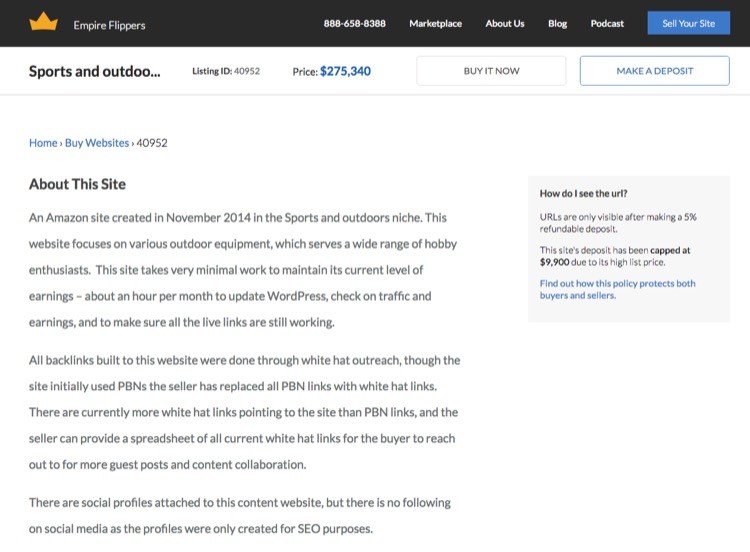
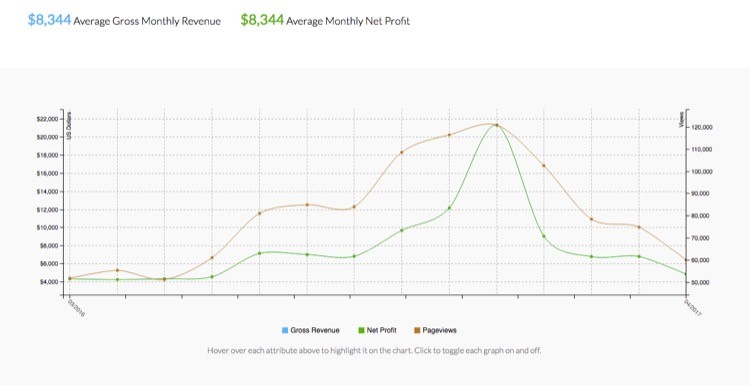

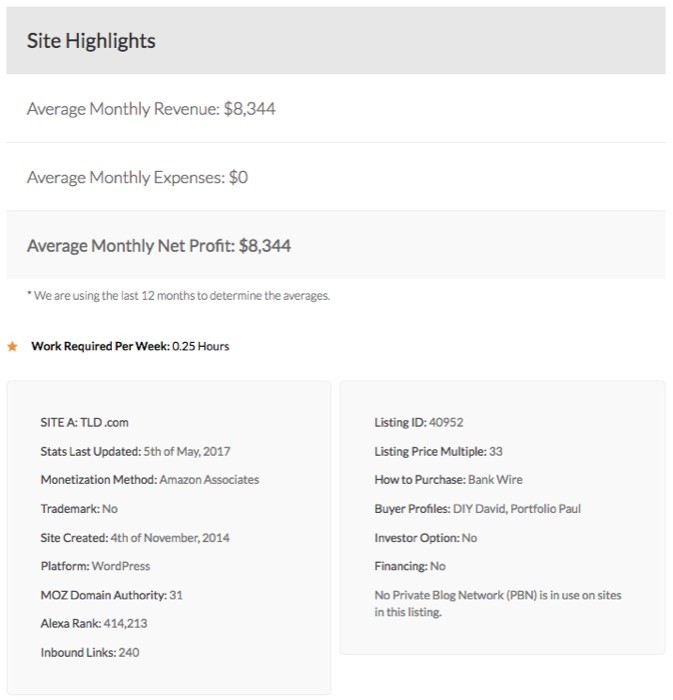

It received a 33x monthly multiple, which is quite good. We were happy with that.
Did the White Hat links increase the value? Yes, and here is what Empire Flippers had to say.
I chatted with Greg on the E.F. team:
Yes! White Hat links for sure can add value to the website’s overall value.
There is another super valuable thing to having white hat links though.
It dramatically improves your buyer pool. We both know how myopic SEOs can be on certain types of links, and even savvy/unsavvy buyers who are not SEOs can be a bit sketched out by some link profiles.
So it improves your negotiations on price and can get more risk adverse (but cash heavy) buyers to take the dive. Which can also lead to smaller earn outs for really big websites.
The Offers
It’s a lot of money. Literally, it’s more expensive than the town home I live in.
Many people know what it’s like to finance a house. You have to get a mortgage because most people don’t have that much cash.
I’m telling you that because selling a site at this price means that the offers might be creative.
- Buyers want to limit risk
- Buyers may not have all the cash upfront and need to pay over time, i.e. seller financing.
Let’s review some offers and ideas that were on the table. By the way, Rob handled talks with potential buyers after they made a deposit and worked with Empire Flippers.
May 16: A Weird One
Here’s a weird one that we received after Rob chatted with an investor.
- Sales Price: $250,320
- Upfront: $125,160
- Earn out: $125,160 paid out at 30% of monthly net profit until paid
- Empire Flippers to hold domain during earn to ensure payout terms are met.
We didn’t like this one at all. There are too many contingencies and we’d bare so much of the risk though the payout period. The kicker was that it’d take about seven years to pay off the remaining 50% of the sale price with a realistic earnings payout. We’d have no control on improving the revenue or decisions on content or outreach.
May 18: Less Weird But Incomplete at Best
Rob talked to an interested person that thought the site was worth more like $200,000 and wondered if we’d even consider that range. (We were open to it depends on several factors.)
The potential buyer wanted to keep the systems and processes in place:
- The ones for content
- The hiring process
- The system for outreach, and so on
We were fine with all that. In fact, you can pretty much get those if you just sign up for the Niche Site Project email list!
When we got the offer, we weren’t impressed.
- Sales Price: $200,000
- Upfront: $150,000
- Earn out: ,000 per month if the site made ,344 in a month. If not, no payment would be made.
The major issue here is the payout criteria. Since the earnings have been lower for the site, hitting the $8,344 mark would be rare until the retail season. That pretty much kills the payout for the remaining $50,000.
And what if the site makes ,000 one month and ,000 for the rest of the months? Do we still just get the $5,000 payout amount?
The offer wasn’t well thought out and didn’t cover a lot of scenarios that could happen. This is why is seems incomplete: it doesn’t address some really basic scenarios about things that are likely to happen. I didn’t even try to think of unlikely things that could happen…
But they were interested, we were willing to negotiate, and we needed to really figure out what part of the offer was important to them.
Was it the earnings level? The cash upfront?
An important factor for us was to have a short payout period, which is really seller financing when you think about it.
Ideally, it would be an offer where all the cash is paid upfront: no payout period.
Negotiations and Counter Offers
Empire Flippers helps you structure the counter offers so that makes it easier. They will let you know if you’re off base and what to do to improve the counter offer. They know more about what’s important to the potential buyer so that bridges the gap in the negotiations.
I won’t share all the counter offer details here — it’s confidential — but I’ll give you one example.
For the offer that we received on May 18, we countered with a more specific progressive payout schedule that addressed our concerns:
Site Earns || Payout
- $10,000 = $6,500
- $8,344 = $5,000
- $6,060 = $3,000
- $4,545 = $2,272
- $3,030 = $1,500
- $3,000 and below no payment will be made
- Waiting for the right offer
It’s a big decision like selling a house and even though Rob and I want to sell fast, we have to be realistic and practical.
Some of the offers were unclear, and from my perspective incomplete. They don’t cover the contingencies that are possible and even likely.
Normally, that wouldn’t really matter much, but some of the offers extend out for months and even years for the payout.
Ideally, we want to see as much of the selling price upfront with no payments. If there are payments, usually based on a percent of ongoing revenue, we want that period to be as brief as possible.
No 14-month seller financing plans. We bare so much risk and have very little upside.
So we wait.
In the NEXT UPDATE:
- We get another interview and offer.
- The winning offer.
- Transitioning the site to the new owner.
Sold – The Winning Bid
May 2017 was a weird month for me.
Huge mood swings.
 My 15 year old dog, Brodie, was dying of cancer.
My 15 year old dog, Brodie, was dying of cancer.
I was also in the middle of the biggest financial transaction of my life.
I remember walking Brodie one morning, like we do every morning — rain, shine, or subzero temperatures.
He was getting slower and slower. Barely wagging his tail.
Then, I’d see a Skype notification from Rob about a interested buyer or a new offer for our niche site. People were really interested in the site, and that felt good.
In this update, you’ll learn:
- Why we were very nervous about what the site was worth
- The offer we so GLAD we didn’t accept
- The offer we accepted
By the way if you haven’t read the other 10 parts of Project Go White Hat, start here.
The Timeline
- May 1: Site is listed with Empire Flippers (see the listing) for $275,340, a 33x monthly multiple.
- May 16: Offer received for $250,320, BUT it’s a bad deal. It’s $125,160 upfront and an earn out that’ll take years to pay off. (see other offers in the last update)
- May 18: Another interested buyer interviewed with Rob and seemed interested.
- May 19:
- We received an offer overnight for $200,000 with $150,000 upfront. Not great.
- I know Brodie isn’t doing well in the morning. He can barely walk and doesn’t want to stand up so I know it’s time — he’s letting me know.
- My wife and I took Brodie to the vet in the afternoon to put him to sleep. We’re devastated.
- May 23: Another interview, another offer for $180,000 with $135,000 upfront.
- May 25: We get the winning offer.
- May 30: The full sale price is in escrow.
Yeah, ups and downs.
One of the tough parts with Brodie was that I’ve worked from home for several years, even for my corporate job.
I’ve literally spent about 20 hours a day with him, everyday, for the last six years. That’s more time than people spend with their spouses or kids.
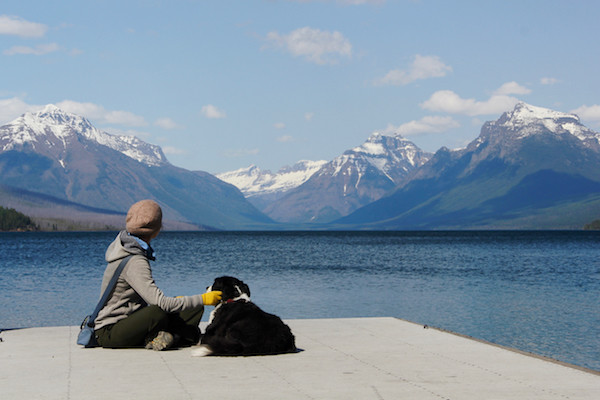
Okay. I know you’re here for the Go White Hat Case Study so I’ll get to it.
The Winning Offer
I got this message from Rob:
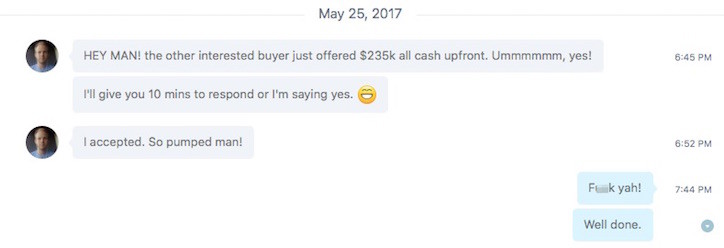
So he didn’t give me 10 minutes, but I was a-okay with his decision!
We formally accepted the $235,000 offer which was paid in full, all upfront, no payout plan.
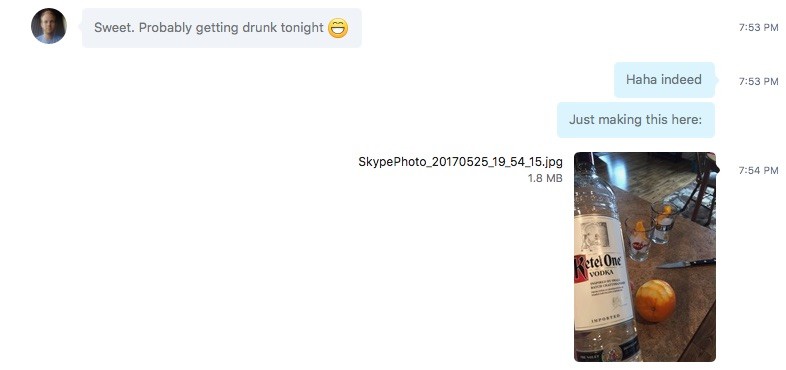
One of our biggest issues with the offers we got was the big component of a payout, usually based on earnings of the site.
That’s a HUGE risk for us as the sellers.
- We have no control over what happens to the site once the new owner takes over. They could add a bunch of bad links or get kick out of the Amazon Associate program for another site they own.
Thinking about selling a 6 or 7 figure business?
You should be aware that you may get offers that have a significant payout component. It’s rare for people to have that much cash, even investment groups.
An investment group is definitely trying to limit their risk, and buying a website is riskier than, say, buying real estate.
Just getting to a point where you have a six or seven figure business is amazing. But if you’re planning on selling, then you should be aware that things might be different than you expect.
We got several offers in the $200,000 range, up to $250,000. The issue was that long payout component which is seller financing. It’s not unusual for sellers to help finance the deal with large selling prices, but that’s really not what we were looking for.
We came really close to countering (and maybe accepting) the offer we got on May 23 for $180,000 with $135,000 upfront. That was just two days before the winning offer came in.
The Transition to the Buyer
One of the great things about working with Empire Flippers is they handle all the transition from the seller to the buyer.
So the transition is easy!
They handle the migration from your hosting to the buyer’s hosting account. They update the affiliate links to the owner.
Waiting
The new owner takes over the site, but we didn’t get the money yet.
The $235,000 sits in an escrow account while the new owner verifies two things:
- Traffic on the site.
- Earnings on Amazon.
The verification period is short, about one to two weeks.
So May was a tough but exciting month. It was great to get the winning offer, and of course, really tough to lose Brodie.
In the NEXT UPDATE:
- I talk about why we sold and didn’t grow the site.
- The new owner gives us an update on the verification.
- The escrow is released.
The Payoff – Check’s in the Mail
Welcome to part 12 of Project Go White Hat.
In Part 11, I revealed the winning offer for our site. It was $235,000 all upfront with no long payout plan.
This post closes out the series, and I’ll share:
- Why we sold and didn’t grow the site.
- The new owner verifies the earnings and traffic.
- The escrow is released.
Why Sell?
People kept asking me why we sold the site. It’s a valid question. Here are some interesting facts:
- The site averages 2,500 visitors a day over the last year
- The site made over $10,000 in September 2016.
- The site made over $32,000 in December 2016.
- The adjusted monthly revenue was about $8,300 per month. (That’s taking the commission rate adjustment by Amazon Associates in March 2017, effectively a 35% drop.)
- We removed 45 Private Blog Network (PBN) backlinks and replaced them with White Hat Guest posts.
- The monthly expenses are close to $0— just VPS hosting which is very cheap.
So people wonder why not keep the site, keep the generally passive income.
I got this question on a YouTube Live stream:
Why don’t you use your system, Doug, and increase the earnings even more then sell it? Your systems and processes are the most valuable thing…
Interesting question.
I’ll explain the context of the entire project and reveal the early thinking which eventually drove the decision to finish the project.
Initial Planning
The initial goal was to convert the site from Gray Hat to White Hat, meaning change the PBN links to guest post links, so that it would be easier to sell.
The First Target
Our general target was the mid $200s because the site was making about $10k per month for three months. Before it reached $10k per month, it was in the $5k to $7k range. So that’s why the mid $200s would be a great selling price.
Planning
Rob and I held a couple planning meetings to discuss the possible work streams and phases of the project. Basically, this was brainstorming and there were some bad ideas. We threw out the bad ones and kept the good ones.
We were left with the core areas:
- Get Guest Posts (Owner: Doug)
- Remove PBN links (Owner: Rob)
- Improve Content (Owner: Doug & Rob)
Content Helped Traffic Explode
Once we got started, the traffic went up dramatically! About 40% in about 30 to 60 days and the revenue followed. It kept increasing to the point that by December, the site made $32,767 which was aided by the retail season.

When the revenue in December went up to $32k, we realized the site could have a much greater value overall.
I remember talking with Rob on Nov 30 or Dec 1 and made predictions for the December earnings. I guessed about $24k, Rob guessed about $23k…so we were WAY off even in December.
We reset our goal to sell the site for the mid $200s to over $500k.
(It was an aggressive goal, a stretch goal, and it was an OUTSTANDING headline. As a marketer, I couldn’t resist proclaiming that we were trying to sell a site for half a million bucks.)
Unfortunately, a lot of things changed from December to March that were out of our control. The biggest was the Amazon commission rate change.
Back to why we sold the site versus putting in more time... Our plan was to sell it from the beginning.
So we adapted as things changed, but the main goal never changed. We talked about trying to recover and increase the earnings, but we didn’t have a strong interest in working on the site more.
New Owner Verifies Traffic and Earnings
This was a short, easy process. The Empire Flippers team transferred the site over to the new owner, and the new owner has about two weeks assess the traffic and earnings.
If the traffic and earnings are what’s expected, i.e. on par with the existing traffic and earnings, then the new owner gives the “okay.”
Then, Empire Flippers release the money from escrow.
Here’s how I found out:

And that was it. We got paid on June 15 officially.
What’s next?
I’m going to take a little break. 🙂 I’ll take a few weeks off from blogging here at Niche Site Project.
- I’ll be hiking a little bit more.
- I’ll be working with students for Multi Profit Site closely.
- I’ll be doing some videos for my YouTube channel.
I expect that Rob and I will have some thoughts after reflecting more about selling the site. So I there will be a part 13 of this series to finish off this case study.
Also, Rob and I have never met in person, and I expect that we’ll get together before the end of the year. Rob will be in the US again soon and we’ll share some IPAs or maybe Double IPAs.
